#learning shavian
Explore tagged Tumblr posts
Text
Learning Shavian and decided to add Shavian translation over my normal name.

1 note
·
View note
Note
do u have a reccomendation for what form of shorthand to learn first. deeply interested-- i saw ur reply on that one post and then u seem cool so i just followed u and figured i would ask here
hello !!! thank you for asking !!!!!!!!!! and im so sorry this is so long lol
If you want my biased personal recommendation, I would suggest Pitman New Era. That's what I use, and I think its the best balance of efficiency vs difficulty to learn, and I like that the learning curve is such that, as you learn, you apply more rules that simplify the writing process more (meaning that earlier practice is still legible, if far less efficient). This compared to other forms (like Gregg) where, as you learn, youre just kind of generally suffering and trying to get your brain to memorise things and differentiate very similar looking strokes. I find Pitman also lends itself well to using in conjunction with other "standard" writing styles so you can take notes that are enough in "standard" writing to be skimmable while using enough shorthand to be much faster to write, basically maninmising writeing AND reading speed. [example below]

You can skip to the end for resources for Pitman and shorthand in general if this answer is sufficient :)
If you want a horrifically long, massively autistic answer that breaks down the three most popular/common styles, then thats what the rest of the post is !! It is so fucking long I am so sorry
Horrifically Long Answer:
I'm answering on the assumption that you would be learning for use with english. If you want to learn shorthand for another language there are a variety of options however I am less versed in them :( I'm also assuming you're asking out of personal interest rather than vocational, since certain jobs will recommend or require you learn certain styles of shorthand and it would be best to defer to that.
The most popular methods are Gregg, the various forms of Pitman (this is what I use), and Teeline. Gregg and Pitman are phonemic while Teeline is alphabetical. There are also a huge number of other, less popular forms of shorthand (as well as shorthand systems which are popular in/made for other languages). If you're interested in learning about these, check out the subreddit listed at the end of this post under "resources".
Teeline:
I know much less about Teeline, so I'll go into it less, but basically it is a "spelling-based" shorthand system -- that is, it is based off the standard spelling of words. It replaces latin letters which different forms that are faster to write and can be connected more efficiently, while removing extraneous letters from words. It is simpler to learn, in part because it is spelling-based, and also because it has fewer rules which further consolidate and shorten word forms. Due to this, it is ultimately much slower to write than the other two systems mentioned here (although you can still get up to good speeds !!). Like the other shorthand systems, you can learn to a more basic extent, or learn more advanced theory to maximise its capability and speed. Teeline is very standard for journalism and overall quite popular for professional use, however it is still in copyright and so there are far fewer resources available online. If you are interested in taking classes, however, I would assume those are available.
Teeline TL;DR: alphabetical, simplest to learn but less efficient, popular, still in copyright so fewer resources.
examples of Teeline:
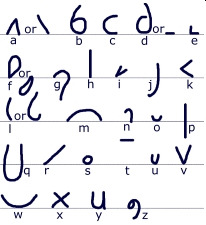


[images sourced from wiki]
Pitman and Gregg: Phonemic Systems and Regional Accents:
As mentioned, Gregg and Pitman are phonemic. If you dont have any practice with phonemic writing systems, you might have luck starting out with shavian just to practice. also because shavian is fun :) (its one of the writing systems in my header !) Im saying this partly because I want more people to learn shavian and partly because I learned Shavian long before I learned Pitman and found that having that practice was helpful. In particular, if you have any accent other than RP, its helpful for figuring out either which vowel sounds and phonetic spellings are relevant to your accent and your pronunciation, or, should you choose to go a "standard" (RP) route, how certain words should be spelled despite how you may pronounce them. Using a "standard" RP approach can be helpful if you want people to more easily be able to read your writing or want to "match" the dictionary, but someone well versed in shorthand should be able to figure it out no matter what, and if its just for your personal use I'd suggest just going by your own regional pronunciations.
Pitman:
Pitman was an early shorthand system developed in the early to mid 1800s. It used to be the most popular shorthand system, however nowadays has been eclipsed in popularity by Teeline and/or Gregg, depending on the country and occupational context. However, it remains popular among enthusiasts and there are significant amount of resources available for learners and practitioners.
The main thing to know with Pitman is that words are built using different strokes for each consonant sound, and symbols attached to these consonants to mark vowels. These consonant sounds are differentiated by shape as well as line thickness. Voiced and unvoiced pairs of consonants (eg., T and D, C and G, S and Z, etc.) are designated using the same strokes, with the voiced consonant of the pair being thicker than the other. This line variation is something which is normally achieved with a pencil, though I mostly use fountain pens to write and so I use flex nibs to achieve the same effect.
Vowels are marked with certain dots or dashes placed along corresponding consonant markings, For increased writing speed, most vowel markings can also be left off in Pitman, and instead where on the line the first stroke begins serves to signal the first vowel.
Pitman uses short forms (also called "logograms" or "grammalogues," depending on the version and book you use) which are abbreviated forms of commonly used words (see picture below for a few examples). Different versions of Pitman have different numbers of grammalogues.
With Pitman, efficiency is increased through a combination of memorising various short forms and implementing rules which simplify strokes. (Examples of these can be seen in the picture below. probably need to click to be able to actually see anything rip) This allows you to have certain "levels" of complexity, where as you learn more complex rules you increase in efficiency, but you can also eschew some of those rules if they are too complex for you without sacrificing legibility to you or proficient practitioners. Probably someone somewhere on reddit has something to say about that but tbh who gives a fuck. You can do whatever you want forever. Its known to be very common for people to come up with their own personal shortcuts and variations in whatever shorthand system they use, and imo sometimes that just means looking at a rule and going "well thats stupid👍" and ignoring it. Pitman can seem really intimidating, however just remember that you can ignore rules for as long as you want until they are less intimidating to learn and apply.
There are 3 "main" versions of Pitman: the original system, Pitman New Era, and Pitman 2000. New Era has the most complex system of rules and abbreviations, while 2000 simplified many of these and got rid of most of the abbreviations. I personally use New Era, in part because I was able to access more resources for this, but largely because I found the increased number of rules and abbreviations to be better in the long run. If you are willing to invest more time and effort into learning a more complicated system, with the tradeoff that it will be faster and easier once you are proficient, you should learn New Era. The main benefit of 2000 is that the rules are simplified. I would say, however, that the downsizing of the list of abbreviations is not a benefit. While it in theory requires you to memorise more individual symbols, in practice these abbreviations are commonly used enough that they can become automatic with very little practice. If you decide to learn 2000, I would suggest taking he time to go through the list of abbreviations from New Era and, if not learning all of them, picking out the ones you think you are likely to use with semi-regularity. If you compile them into a cheat sheet and hand it next to your desk, they should be easy to practice using and become memorised really quickly. I myself dont have every abbreviation memorised, but instead focused on ones i use regularly, and often go through the list again to pick out new ones to learn and add to my lexicon as I think they may be used.
Pitman TL;DR: phonemic, differentiates strokes through line thickness, rules can be applied or discarded as best suits your practice without sacrificing readability. Increased speed and efficiency is achieved through extra short forms for commonly used words, and rules which simplify strokes.
examples of Pitman:
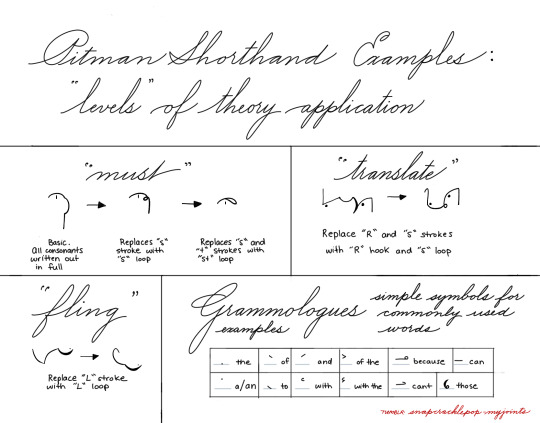


[first image mine, other two images sourced from Long Live Pitman's (website, linked below), and wiki]
Gregg:
Gregg is a very popular form of shorthand which utilises round, smooth strokes with the intent of increasing writing efficiency and legibility.
Where Pitman uses variation in line thickness to differentiate between strokes, Gregg uses line length. Both consonants and vowels are marked with designated strokes (compared to Teeline, which has vowel strokes but tends to omit them where possible, and Pitman, which adds vowel marking to consonant strokes or signals vowels through figure placement), and vowels are largely kept in-line. With Gregg, efficiency is achieved through the use of short forms, prefixes, and suffixes; "phrasing", (wherein certain phrases, such as "I may be," "one of the most," "by the," etc. are combined into a single stroke); as well as through the more efficient way in which strokes are joined together into words.
Left-handed people sometimes write Gregg from right to left.
Like Pitman, there are a number of different versions of Gregg, however Gregg seems to have significantly more versions and significantly less consensus around which version is best or why. I am not the best person to give advice on which one is best or information on the different types, so if you decide to go with Gregg I'd suggest checking out the subreddit or some of the other resources linked below for information on that.
examples of Gregg:

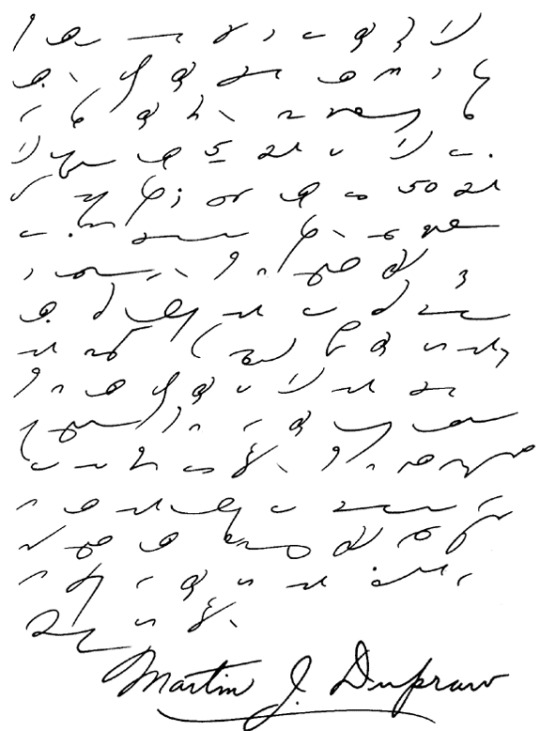

[Images sourced from wiki and gregg-shorthand.com]
Comparisons:
I would say that one of the main things to consider if choosing between Gregg and Pitman is which you think is more intuitive to read and write for you. Which sounds obvious lol but like. as an example. I struggle with spatial awareness and stuff like estimating lengths so for me Gregg is not a good option since it differentiates certain consonants through their length and I would have a hard time writing those consistently or easily reading them. Pitman is easier for me in that regard, as well as since it is more "choppy" (for lack of better word) which makes it much easier for me to recognise certain words without having to break them down, as well as making it easier for me to break them down to read them should I need to. On the other hand, some people find Gregg to be easier since its much "smoother" and flowier to write, which can be much faster and more intuitive for some.
Compared to Pitman, Gregg has significantly fewer rules to learn, making it in theory simpler, however, due to the way it is written, it requires significantly more practice to be able to consistently properly write and tell apart certain letters, words, and phrases. Once you are proficient in this, it is by far more efficient, however Gregg is very difficult to use while you are still figuring it out. Pitman, on the other hand, has significantly more rules, however you can continue to easily use it as you learn these rules and add them into your practice. The downside of this is that once you are fully proficient, it is less efficient than full proficiency Gregg. Essentially, the main difficulty with learning Gregg is telling apart different strokes and writing them so that they can be differentiated, while the main difficulty with Pitman is in learning the rules.
I havent talked much about Teeline because honestly I know far less about it, because it is so much harder to find resources on, and honestly because I'm a bit of an old man and personally prefer the older styles lol. Its popular for a reason, though !
I know it probably sounds like I'm shilling a lot for Pitman, however thats just because its what I use and know the most about, as well as because it is what works best for my unique considerations. Most people would probably be more likely to recommend Gregg (for a number of very good reasons !), however when I was first deciding which shorthand system to learn I saw very few people making the points that were most relevant to me (eg, that pitman can be used AS you learn, whereas Gregg is more of a "its useless until you actually have it down" situation, that Gregg is really difficult if you struggle with differentiating lengths, etc) so I feel the need to mention them
TL;DR: Everything:
Ultimately you should use whatever you think is best for you :) I'd say Teeline is your best bet if you are in journalism, or want something easier. Gregg is best if you want something popular, smoother to write, and extremely fast, and are willing and able to put in significant amounts of consistent work and practice to master it. Pitman is best if you want something you can use as you learn, and that's somewhere in between Teeline and Gregg in terms of difficulty and efficiency. If you wanted, you could probably learn Teeline as well as either Pitman or Gregg, but learning both Pitman and Gregg would be much more difficult.
Other:
I take all my notes by hand, generally using a mix of palmer method cursive and pitman shorthand to do so, however, I also have to write a lot of papers, and when I do, I get frustrated at having to type out whole words I normally write in shorthand. This is kind of the curse of shorthand, you get really annoyed having to type out "because". To deal with this, while typing in a word processor, I use an alphabetic shorthand I've come up with over time. I basically input a bunch of auto-replacements into my spellcheck, so that I can have shortcuts for commonly used words set up. so basically i can write: "here, . cnstrctn ` ntnl idntty served to lgtmse the ntn stte" and it will autocorrect to "here, the construction of national identity served to legitimise the nation state". Highly recommend this if you do a lot of writing, especially if a lot of the same topics and words come up a lot. Use whatever shortened versions feel intuitive for you, instead of something you've consciously + intentionally constructed, otherwise youre more likely to forget them or have them get mixed up.
Resources:
stenophile.com has a huge number of shorthand resources linked, particularly for Gregg and Pitman. If you end up choosing either of these I'd suggest starting here to find instruction books.
this website can transliterate into Pitman and Gregg, DEK and Stolze-Schrey (two German shorthand systems), and Sütterlinschrift (a historical German script)(also in my header !)
r/fastwriting is run by a very nice very dedicated man who posts a huge amount of content and resources on various shorthand methods, including lesser known ones. If you decide you want to learn/learn about a different shorthand system, he's the guy to talk to. This subreddit differs from r/shorthand or system-specific subreddits like r/greggshorthand, as those are more discussion-based for learners and practitioners, while r/fastwriting is better for research and being autistic. R/shorthand does have a number of resources listed for more popular shorthand systems, and is a good place to go for advice while learning.
Teeline:
blog with a few free resources
Pitman:
Pitman New Era Instructor and Dictionary. These are what I largely used to learn.
Long Live Pitman's: a website dedicated to Pitman, full of good information for beginning learners.
if you learn Pitman, as mentioned the line variation can be accomplished with a pencil, however if you want to get a bit fancy with it while staying on a budget, Fountain Pen Revolution carries a number of cheap yet reliable fountain pens with flex nibs, such as the FPR Indus or Himalaya. I'd suggest the steel flex rather than the ultra-flex for shorthand unless you have a lighter hand or have practiced with a flex pen before. I've also heard good things about the Noodler's Ahab pen but honestly find its very temperamental, needs tweaking (not ideal if youre a fp beginner) and just not as good. Both FPR and Noodler's pens are made of bioresin and must be kept away from solvents like isopropyl alcohol !!!
Gregg:
Gregg Phrasebook. Short guide to phraseology for Gregg
Gregg-shorthand.com: seems like a good place to start for learning Gregg. Answers some beginner's questions, and provides learning aids and reading material (transliterated into Gregg)
r/greggshorthand
greggshorthand.gibhub.io: a more in depth website with a number of book pdfs and lessons for various forms of Gregg.

#ahhh thank you for asking !!!! i love the opportunity to rant about this lol. im sorry this is so long also lol#if you want to know more abt anything in particular or want me to simplify anything since i know this is a lot lmk !!#and if you end up learning shorthand id love to hear about it <3#especially if u learn pitman i can send u some of the cheat sheets and shit i made and stuff.#i admittedly will be less help with other shorthand systems but id still love to hear abt it :)#ask#homeybee#shorthand#pitman shorthand#gregg shorthand#shavian#teeline#ceci says stuff#undescribed
43 notes
·
View notes
Text
It would look like this:
𐑚𐑰𐑐
youtube
Fascinating 🧐 I wonder what "BEEP" would look like in Shavian
#shavian is pretty cool#new hobby#I'm learning it WAY quicker than I thought#it's not like learning a language it's like learning a tenth of a language#I'm getting what I consider good at Shavian after only about a week
217 notes
·
View notes
Text
i found a shavian keyboard for my phone so i'm going to learn shavian tomorrow to annoy you guys
3 notes
·
View notes
Text
Recently learned about the Shavian alphabet, an attempt to create an optimized script better for writing English than the Roman alphabet. I have some nitpicks with it, but overall it's pretty cool!
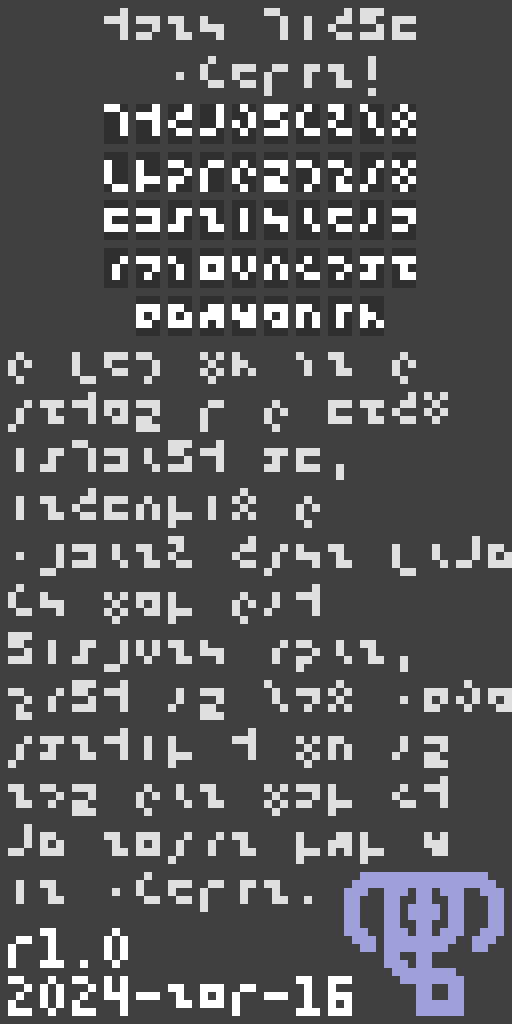
…So naturally it didn't take long for me to make a tiny pixel font of it.
3 notes
·
View notes
Note
explodes
im like halfway through learning the shavian alphabet :OO
its sooo confusing tho that there are flipped things
like
um
𐑓 (fay) 𐑝 (vie) 𐑚 (bell) and 𐑐 (pin)
umm yea
whoa look im so cool and smart learning another alphabet for the first time (shhh don tell my parents who tried to teach me hebrew and thai for years--)
*laughs nervously in 8 years of hebrew school and only knows like twenty-five words* i'm trying to learn more i swear--
5 notes
·
View notes
Text
Just learned about Shavian, an alternate English phonemic alphabet, and immediately clocked that it's the same basic idea behind the language in Tunic
I don't know if the devs were inspired by it, but looking over the characters, I have to imagine that they were at least aware of it
#language#tunic#shavian#i'm so tempted to teach myself shavian or quikscript and then exclusively write in those when writing by hand#cus honestly i HATE writing in the latin alphabet. my handwriting has always been atrocious and i frankly don't care for english spelling
3 notes
·
View notes
Text
I'd be a bookbinder, and a baker. That's what I do when I have time off (which is rare and double edged).
I'd run part of a shop, half coffee shop half bakery, with a sitting area and library. There's an apothecary next door.
You could bring me anything written you like and in several days I'd bind it for you. If you wanted a book and could point me to a digitization of it's contents, I'd make that fir you too.
I'd learn languages and translate books. I already transliterate between Latin and shavian characters, slowly, one word at a time while my professors prattle on.
The people who say shit like "I don't dream about labour" when asked about their dream job make me sad. It's not their fault and it's an obvious conclusion to come to in the environment that we live in, but they really do seem to make no difference between work, and being exploited. You do want to work, it is inherent human nature to want to do things, you just don't want to slave for shit wages while making profit for someone else.
If art wasn't an option and I didn't have to worry about being profitable, I know what I would be doing: Keep a little shop selling secondhand-thirdhand buttons and buckles.
Thrift shops and secondhand stores could dump (or sell, whatever) their unsold and unwanted goods to me, and I could spend all day going through the heaps and picking them apart, plucking the still-perfectly-good buttons, zippers and buckles out of discarded things with threadbare fabrics and sell them.
Probably also making those little trinket storage boxes out of hollowed-out books. By hollowing out books that nobody wanted or read.
17K notes
·
View notes
Text
pov u and ur friend learn shavian so you can send each other notes in class :>
1 note
·
View note
Note
i think ya asked me about my fursona a couple days ago
anyway
i drew him
:33

(his sweater says 'milo' in shavian)
i did !!! i love seeing peoples fursonas
he is soosoo cute omg,, i need to learn how to draw anthro animals NOW
1 note
·
View note
Text
Just learned about the shavian alphabet, I think I'm gonna try to learn it for note taking purposes. It's pretty neat and will make a better shorthand for proofs.
0 notes
Text
THISSSS
My ex didn't manage to learn Shavian, but they gave it an honest try and that meant the world to me
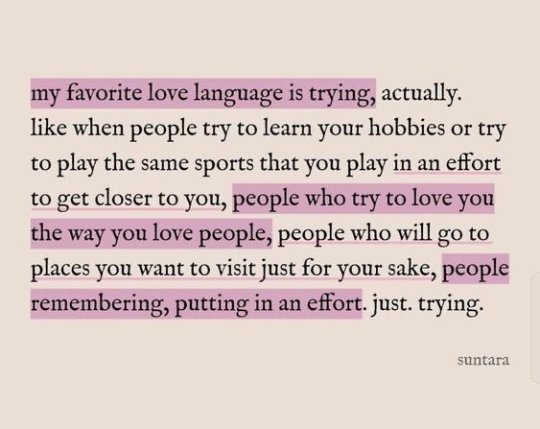
36K notes
·
View notes
Text
youtube
@_@ HOMG, I LOVE IT!
or 𐑣𐑴 𐑥𐑲 𐑜𐑪𐑛, 𐑲 𐑤𐑳𐑝 𐑦𐑑!
I totally want to know about other entries in the contest.
I had a random plot in the extended zero draft (will definitely not be making it into any book I write, though I dunno, if @coatntails ever decides to sit down and write her books about the back end, it might go in there) where Tosh (minor character who is the little sister of the boyfriend of the rule 63 version of James stolen from another timeline... yeah, ok, I can see why she's nervous about even figuring out how to even start those books) ends up trying to use her position as one of the inner circle of Founders of Nu Laputa ( ·𐑯𐑿 ·𐑤𐑳𐑐𐑿𐑑𐑷? Maybe, I think. Or maybe ·𐑯𐑿 ·𐑤𐑨𐑐𐑿𐑑𐑷... hmmm) to force a more logical way of dealing with language. She was gung-ho on the IPA, so it did tell you exactly how to pronounce it - the way the founders did.
I was definitely interested in how Laputian (·𐑤𐑨𐑐𐑿𐑖𐑩𐑯) would evolve as a language into that world's future, just wasn't quite sure how to work on it. I definitely think of Laputa as a deeply cosmopolitan clash of very different cultures spitting out something only vaguely recognizable. I was very curious intellectually about what might spit out in the definitive future. Every so often I think about writing stuff in that setting. Maybe all the writing is actually in something like Shavian instead of the IPA. Since one of the clashes I definitely see happening is English being the dominant framework for how things progress. Too much power is concentrated in the hands of Received American English speakers for anything else to get the top spot. But other languages have populations that are far too large not to have a dramatic effect.
Which is all besides the point, really.
I just really find stuff like this cool. I want more. I wish I had the energy to learn and do more.
#conlang#conscript#I guess it's really just conscript and not conlang#but same interest I feel like#Youtube
1 note
·
View note
Text
I decided to learn Quikscript over Shavian because it's supposedly better for dyslexia and handwriting, and while that seems to be true, Bay and Fee are literally the same character, just one is Deep and the other is Tall. I'm not sure if this was an unfortunate necessity for the sake of maintaining simplicity or just an oversight, but I'm a tad miffed
0 notes
Text
https://en.wikipedia.org/wiki/Deseret_alphabet
The Deseret alphabet was an outgrowth of the idealism and utopianism of Young and the early LDS Church. Young and the Mormon pioneers believed "all aspects of life" were in need of reform for the imminent millennium, and the Deseret alphabet was just one of many ways in which they sought to bring about a complete "transformation in society," in anticipation of the Second Coming of Jesus. Young wrote of the reform that "it would represent every sound used in the construction of any known language; and, in fact, a step and partial return to a pure language which has been promised unto us in the latter days," which meant the pure Adamic language spoken before the Tower of Babel.
In public statements, Young claimed the alphabet would replace the traditional Latin alphabet with an alternative, more phonetically accurate alphabet for the English language. This would offer immigrants an opportunity to learn to read and write English, the orthography of which, he said, is often less phonetically consistent than those of many other languages Similar neographies have been attempted, the most well-known of which for English is the Shavian alphabet. Young also proposed teaching the alphabet in the school system, stating "It will be the means of introducing uniformity in our orthography, and the years that are now required to learn to read and spell can be devoted to other studies."
Between 1854 and 1869, the Alphabet was used in scriptural newspaper passages, selected church records, a few diaries, and some correspondence. Occasional street signs and posters used the new letters. In 1860 a $5 gold coin was embossed 𐐐𐐬𐑊𐐨𐑌𐐮𐑅 𐐻𐐭 𐑄 𐐢𐐫𐑉𐐼 (Holiness to the Lord). In 1868-9, after much difficulty creating suitable fonts, four books were printed: two school primers, the full Book of Mormon, and a first portion of it, intended as a third school reader.
Despite repeated and costly promotion by the early LDS Church, the alphabet never enjoyed widespread use, and it has been regarded by historians as a failure. However, in recent years, aided by digital typography, the Deseret Alphabet has been revived as a cultural heirloom.
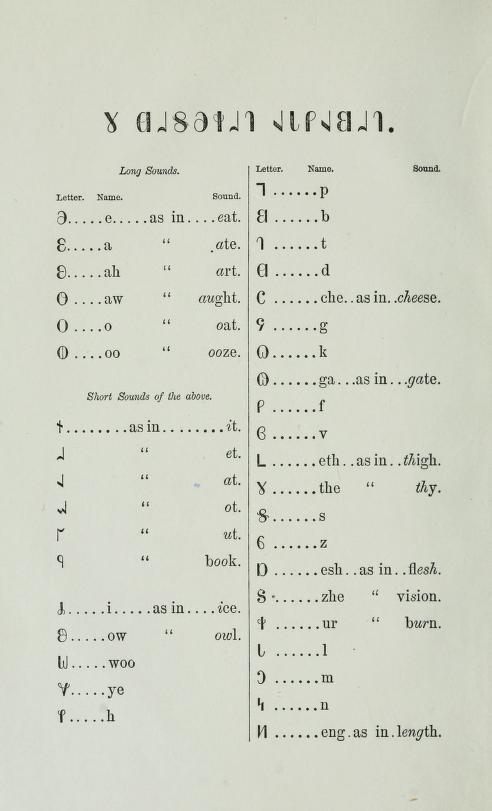
A Deseret chart at the front of an 1869 Book of Mormon. Internet Archive/Public Domain
0 notes
Text

Currently on sale at Smashwords for $2.49
The Interplanetary Trade Coalition has not been welcomed with open arms by the Sha Empire. Isolated at the far edge of a distant system, the Sha are distrustful of outsiders, and previous I.P.T.C. diplomatic missions have ended with members imprisoned or dead. But, if pushed enough, the I.P.T.C. will overrun the planet to take what it wants. The situation is already precarious when student linguist Taji Ameyo is conscripted to translate for the newest I.P.T.C. ambassador. Taji, used to being alone, has never learned to hide his heart or his opinions, and the controlled Sha nobility regard little, outspoken human Taji with fascination, calling him shehzha.
Mysterious, coveted figures, so devoted to their lovers that pleasing them is a test of Shavian honor, shehzha are usually kept out of public view. Taji is a nobody, hardly alluring, and yet it’s not long before his runaway mouth gets him entangled in imperial politics, and he has no one rely on but the soldiers assigned to protect him—one soldier, more than the others.
At the mercy of both a greedy trade coalition and a proud empire, Taji has to determine what it means to be shehzha, while surrounded by ambitious noble families and a sharp-eyed emperor, and hopefully learn enough about the Sha to keep him and everyone he cares about alive.
A queer sci-fi romance
Taji From Beyond the Rings
#i feel like an infographic cannot accurately describe the CHEESE levels#cheeeeeeese#taji from beyond the rings#r. cooper#queer romance#trenne the dreamboat alien boyfriend#taji the genius trash gremlin
59 notes
·
View notes